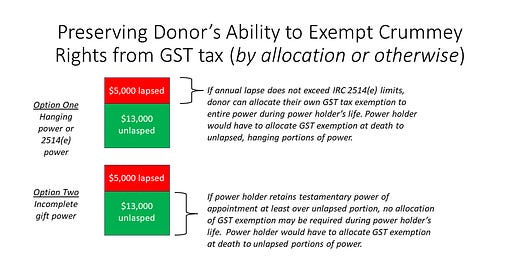Hanging Crummey Powers: The Ultimate Guide to Form 709
Exploring the accounting, and 709 reporting, of hanging Crummey powers
This is a continuation of the series on preparing Form 709. For the last article in this series, click here. To skip to the intro, click here.
NOTE: If you are not a paid subscriber but would like to purchase a copy of this article and the associated download, click here.
Table of Contents
Intro
I explained in great detail the GST tax structure of Crummey withdrawal rights in this prior article. But, to understand gift tax reporting, we must understand the types of Crummey rights involved. For purposes of this set of articles, we will consider three types of powers:
1. Hanging powers
2. Incomplete gift powers
3. 2514(e) powers
This article focuses primarily on hanging powers. Below, you will find a sample accounting for hanging Crummey powers which you can download and use (which may require basic knowledge of Excel formulas).
To preface, all types of Crummey powers should qualify the donor’s transfer to a trust for the gift tax annual exclusion. The gift tax annual exclusion will be the lesser of (1) the total transfer amount, or (2) the inflation-adjusted limit set forth in the Internal Revenue Code (currently $18,000 per donee, or $36,000 per donee for split gifts, community property gifts, or gifts from joint tenancy/TBE property).
However, a hallmark of Crummey powers is that they have a limited window in which a power holder can withdraw their share of a donor’s transfer to a trust, usually up to the annual exclusion available to the donor with respect to such power holder. The issue is what happens after that window expires.
No matter what, the structure of this expiration does not affect the donor’s ability to use their own gift tax annual exclusion. But, it may affect whether, and to what extent, the GST tax exemption of the donor is or should be allocated to the transfer subject to a Crummey right. It may also affect whether a power holder incurs any gift tax consequences – an outcome that should be avoidable with solid trust drafting.
It is this disparity between gift and GST tax treatment of the power expiration that leads to a great deal of angst in preparing Form 709, as the Parts of Schedules A and D on which each Crummey right is or should be reported is going to vary based on the structure of this expiration of the Crummey power, along with the GST tax identity of the power holder as a skip person or non-skip person.
Whether to File
As discussed in the last article, filing may be optional from a gift tax perspective if the only gifts made during the year are under the annual exclusion for each donee. However, if Crummey gifts are being created, one must consider the strategy of allocating GST exemption.
For many Crummey rights, unless subject to an ETIP or created for transfers to a trust that is not a GST trust (both discussed below), GST exemption may be automatically allocated to the Crummey rights. Assuming there is no other filing trigger for the year, one could get away with simply not filing a 709 and relying on automatic allocation.
But, what happens in the even a return does have to be filed for any given year? In such a case, all annual exclusion gifts (including Crummey gifts) must be reported. Further, remaining GST exemption must be accounted for and allocated on the 709. If one has been relying on automatic allocation, there is a higher risk for inaccuracy in the amount of GST exemption available and reported as allocated on Part 2 of Schedule D of the 709. Reliance on automatic allocation requires disciplined accounting that can be provided at a moment’s notice to the 709 preparer.
For hanging Crummey powers, automatic or manual allocation will usually be required. Manual allocation can only occur if a 709 is filed, and switching back and forth between automatic and manual allocation increases the risk of errors. But, one must know if there are hanging Crummey powers before the filing paths are determined.
In a subsequent, we will discuss incomplete gift Crummey powers. Depending on the structure, these powers may not require allocation of GST exemption and may instead be granted a zero inclusion ratio under the Code provisions and Regulations applicable to generation-skipping transfers. Filing a return that allocates GST exemption may create inaccuracies as well. It is important to note that over-allocation is not a significant risk, because allocations in excess of what is needed to create a zero inclusion ratio are void. But, the opposite conclusion must be considered – what if the Crummey power itself does not qualify for a zero inclusion ratio? Should we have a back-up set of books, and possibly 709s, to account for this possibility?
Keep reading with a 7-day free trial
Subscribe to State of Estates to keep reading this post and get 7 days of free access to the full post archives.




